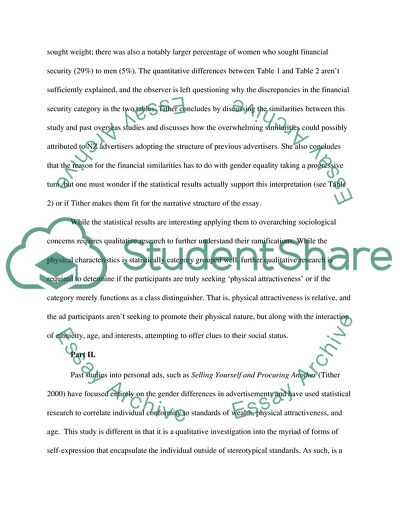
- Home
- Free Samples
- Premium Essays
- Editing Services
- Extra Tools
- Essay Writing Help
- About Us
- Studentshare
- Subjects
- Miscellaneous
- Linguistics- Identities on the Marketplace
Linguistics- Identities on the Marketplace - Essay Example

- Subject: Miscellaneous
- Type: Essay
- Level: Ph.D.
- Pages: 4 (1000 words)
- Downloads: 0
- Author: emcclure
Extract of sample "Linguistics- Identities on the Marketplace"
The majority of past studies have determined that there is a difference between men -- who are more concerned with attractiveness in a partner -- and women – who value financial security, and height. While her study adheres to statistical analysis and is specific to New Zealand, its overarching argument is that differences in the descriptive characteristics of advertisements will be gender specific and speak to the contrasting ways men and women codify and market their identities in modern society.
Tither’s research methods focus on two Canterbury newspapers – The Press, and The Christchurch. The data was edited for relevancy and the final sample was reduced to 38 women and 115 men. The advertisements were then analyzed for five statistical categories – physical appearance, financial security, marital status, ethnicity, and age. Contrary to previous gender based research, the results in Table 1 indicated that there were no significant statistical differences between the amount of women and men who sought physical characteristics in their partner; there was also no significant difference between the men and women who sought financial security.
However Table 2, which shows specific elements of physical attractiveness demonstrates that men more frequently offered their height and women more frequently sought it; there was a significant connection between women who offered their weight and men who sought weight; there was also a notably larger percentage of women who sought financial security (29%) to men (5%). The quantitative differences between Table 1 and Table 2 aren’t sufficiently explained, and the observer is left questioning why the discrepancies in the financial security category in the two tables.
Tither concludes by discussing the similarities between this study and past overseas studies and discusses how the overwhelming similarities could possibly attributed to NZ advertisers adopting the structure of previous
...Download file to see next pages Read MoreCHECK THESE SAMPLES OF Linguistics- Identities on the Marketplace
Sexuality
Considerations of Career Direction
Branding Concepts, Brand Extension and Multi-brands
Cultural Diversity in Contemporary British Society
Endangered Languages and Cultures
The spread of English
Culture, Identity, and Representation
The Issues of Sexual Identity

- TERMS & CONDITIONS
- PRIVACY POLICY
- COOKIES POLICY